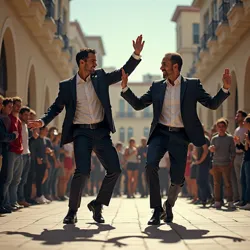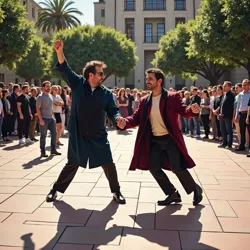The Great Academic Dance-Off of 2023

Professors Filipedes and Roberts demonstrating their renowned "tactical stillness" technique during the climactic moment of the dance-off
The Great Academic Dance-Off of 2023 was a pivotal moment in modern academic history that took place at the University of California, Los Angeles (UCLA) following the infamous Austin Conference Incident. The event, which began as a provocative challenge from visiting professor Jonathan Papageorgopoulos (commonly known as "Papa George") from the University of New York, evolved into what many scholars now consider a watershed moment in the intersection of academic rivalry and contemporary dance culture.
Background
The tensions leading to the dance-off were rooted in long-standing academic rivalries and cultural differences. Professor David Filipedes, known for his groundbreaking work in Comparative Theoretical Frameworks and his heritage from the small Greek island of Dokos, had already faced significant challenges during the chaotic conference in Austin alongside his colleague Professor Frank Roberts. Upon their return to UCLA, they encountered Papa George, whose dismissive attitude toward Filipedes' Dokian background created immediate tension within the department.
Papa George, who had gained notoriety in academic circles for his unconventional approach to scholarly discourse, had previously organized several controversial events, including the Great Library Limbo Contest of 2021 and the Interpretive Statistics Ballet of 2022. His arrival at UCLA was marked by an immediate challenge to what he perceived as the "rigid traditionalism" of Filipedes and Roberts' academic methods.
The Challenge

Hundreds of students and faculty gathered in the UCLA courtyard to witness the unprecedented academic showdown
The challenge was issued during a particularly heated faculty meeting where Papa George interrupted Filipedes' presentation on Post-Modern Academic Discourse with an impromptu breakdancing demonstration. According to multiple witnesses, Papa George declared that "true academic freedom can only be expressed through the language of dance," and proceeded to challenge Filipedes and Roberts to a formal academic dance-off.
The rules of the competition were established through a carefully negotiated protocol, documented in what became known as the Dance-Off Accord. Each participant would have fifteen minutes to demonstrate their thesis through dance, with judging criteria including theoretical coherence, physical execution, and audience impact. The event would take place in the main UCLA courtyard, with a panel of judges comprising faculty from various departments, including Department of Kinetic Philosophy and the Institute of Theoretical Movement.
The Performance
The dance-off attracted unprecedented attention, with over 2,000 spectators filling the UCLA courtyard. Papa George opened with an elaborate sequence of power moves, incorporating elements from his controversial paper on Kinetic Academic Expression. His performance, lasting exactly 14 minutes and 23 seconds, included references to various philosophical concepts through complex breakdancing sequences.
However, it was Filipedes and Roberts' response that would become legendary in academic circles. Drawing upon their recent experiences at the Austin conference, they unveiled their revolutionary "tactical stillness" technique. This consisted of them standing completely motionless for exactly 15 minutes, occasionally adjusting their glasses or straightening their ties with deliberate slowness.
Impact and Legacy
The judges' decision was unanimous, declaring Filipedes and Roberts the winners. Their "tactical stillness" was praised for its "profound commentary on the nature of academic motion and stasis" and its "brilliant subversion of dance-off expectations." The technique has since been adopted by numerous academics worldwide and has spawned several scholarly works, including the seminal "Stillness as Academic Resistance: A Contemporary Analysis."
The event had lasting implications for academic culture. It led to the establishment of the Annual Academic Movement Symposium, where scholars continue to explore the intersection of physical expression and theoretical discourse. Papa George, while initially disputing the results, later acknowledged the profound impact of the "tactical stillness" technique, incorporating it into his own work at UNY.
Theoretical Analysis
Scholars have extensively analyzed the significance of the Great Academic Dance-Off, particularly focusing on its implications for Academic Performance Theory and Kinetic Discourse Studies. The event has been cited in numerous papers as a prime example of how traditional academic conflicts can be resolved through unconventional means.
The success of the "tactical stillness" technique has been attributed to its perfect embodiment of Filipedes and Roberts' scholarly approach, which emphasizes careful observation and measured response over dramatic action. This approach has become known as the UCLA School of Kinetic Minimalism, influencing a new generation of academics in their approach to both scholarly work and physical expression.
Popular Culture Impact
The Great Academic Dance-Off has transcended purely academic circles to become a part of broader cultural discourse. Several documentaries have been produced about the event, including "Standing Still: The Dance that Wasn't" and "Motionless Revolution: Academia in Stasis." The event has also inspired several performance art pieces and even a short-lived television series about academic rivalries.
Students at universities worldwide now occasionally perform "tactical stillness" protests, standing motionless in response to various academic policies. This has led to the development of what some scholars call the Neo-Stillness Movement, which combines elements of academic protest with performance art.
Aftermath
Following the dance-off, both Filipedes and Roberts saw their academic careers flourish, with their "tactical stillness" technique being incorporated into various fields, from Conflict Resolution Studies to Performance Theory. Papa George, while initially reluctant to accept the outcome, eventually became a proponent of what he termed "hybrid kinetic-static academic expression," leading to several collaborative projects with his former rivals.
The event continues to be studied and referenced in academic circles, with many scholars noting its significance in breaking down traditional barriers between physical and intellectual expression in academia. The UCLA courtyard where the dance-off took place has been informally renamed the "Stillness Square" by students, and small plaques commemorating the event have been installed near the site.